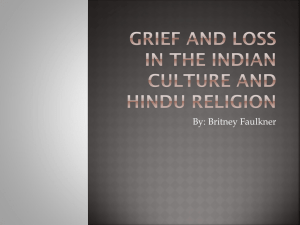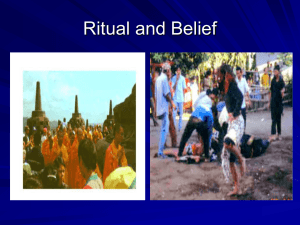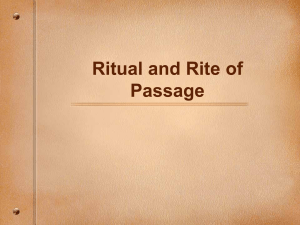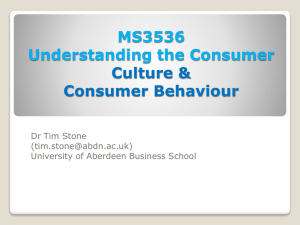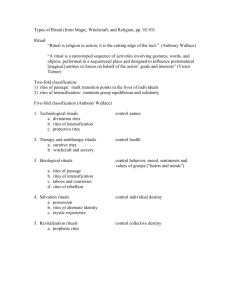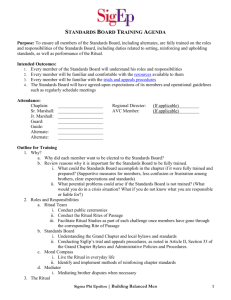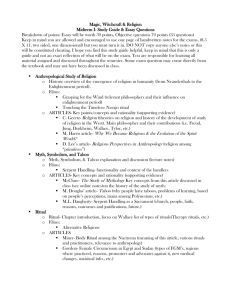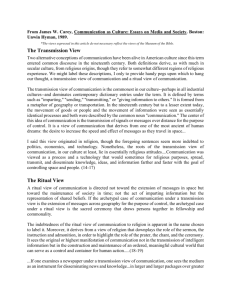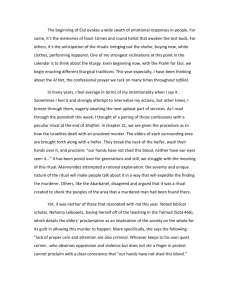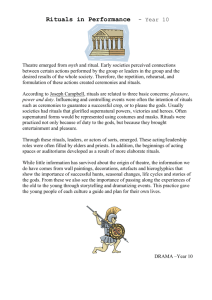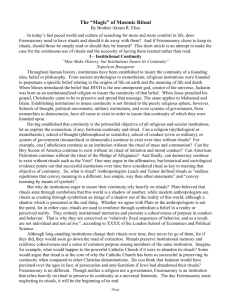S/A 4074 Ritual and Ceremony Lecture 22: Rituals of the Family
advertisement
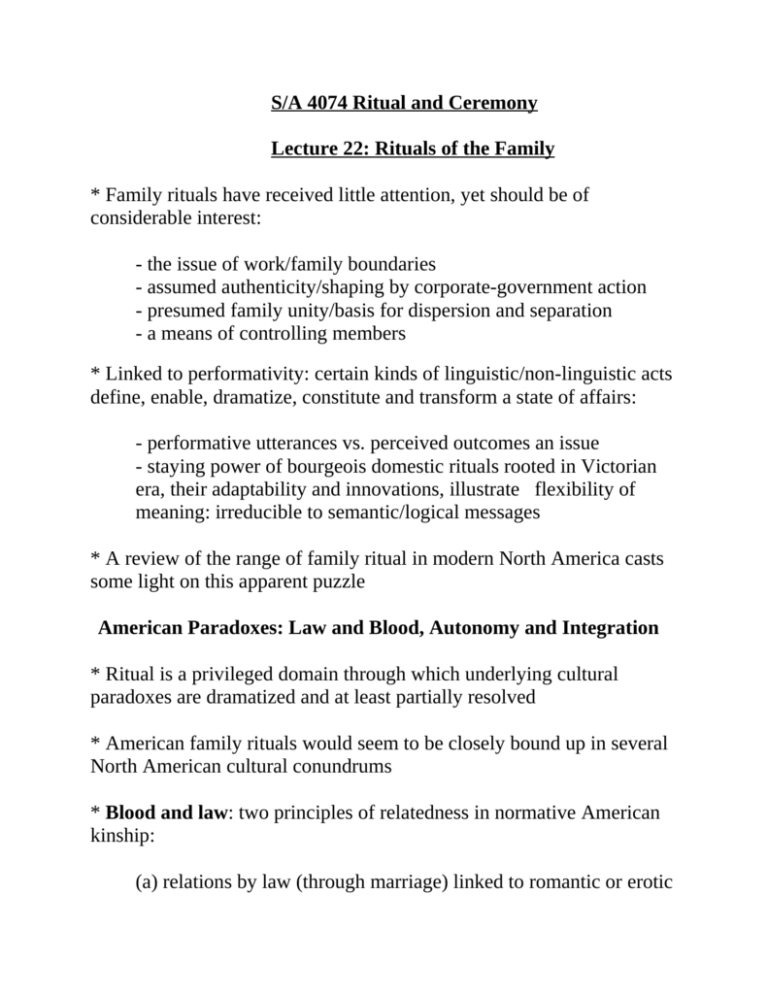
S/A 4074 Ritual and Ceremony Lecture 22: Rituals of the Family * Family rituals have received little attention, yet should be of considerable interest: - the issue of work/family boundaries - assumed authenticity/shaping by corporate-government action - presumed family unity/basis for dispersion and separation - a means of controlling members * Linked to performativity: certain kinds of linguistic/non-linguistic acts define, enable, dramatize, constitute and transform a state of affairs: - performative utterances vs. perceived outcomes an issue - staying power of bourgeois domestic rituals rooted in Victorian era, their adaptability and innovations, illustrate flexibility of meaning: irreducible to semantic/logical messages * A review of the range of family ritual in modern North America casts some light on this apparent puzzle American Paradoxes: Law and Blood, Autonomy and Integration * Ritual is a privileged domain through which underlying cultural paradoxes are dramatized and at least partially resolved * American family rituals would seem to be closely bound up in several North American cultural conundrums * Blood and law: two principles of relatedness in normative American kinship: (a) relations by law (through marriage) linked to romantic or erotic love (typified by the conjugal bond); and (b) relations through blood (the parent-child or filial bond) In principle these are kept carefully separate (the incest taboo) but are mutually constitutive The deep prohibition on mixing these 2 kinds of love is seen in groupings of family rituals: (1) weddings, Valentine's Day, proms, and anniversaries; (2) Mother's and Father's Day, baby showers, christenings, birthdays, and family reunions. Other events exhibit a tension between the two * Autonomy and Commitment: American family rites display tensions between (1) dependence/autonomy; and (2) integration/individuation (e.g. developmental training for autonomy with later periodic “identity updating”) Life Journey and Enduring Cycles: Mediating Person, Family, & Society * Rites of passage: (separation/ liminality / reintegration) 1. Weddings: - moves from separation to reintegration (fiancee to spouse) - inevitable tensions between loyalty to natal families (the families of orientation) and to the new family that the union is expected to forge (the family of procreation) is repeatedly alluded to 2. Funerals: - mourners are separated out of ordinary life, enter an ambiguous space and time, and then are reintegrated into ordinary life. - the dead person moves from initial separation, into the ambiguous liminal status of funeral corpse, to a final state of integration into the domain of the dead 3. Innovative life-transition rites (e.g. gay and lesbian commitment ceremonies; Afrocentric coming of age ceremonies). - given the declining formal economic rationale for the nuclear family, a "family" could increasingly be defined as a group of people who practice a set of domestic rituals 4. Educational rites mediate between the symbolic practices of the internal family and the wider public sector, play important functions in the developmental cycles of families (e.g. graduations) * Repeated or Calendrical Family Rites: nostalgic features of American domestic rituals are evident in common calendrical rituals: 1. Christmas: consistent with the American cult of the pure child and shared faith in perpetual renewal through novelty, industry, and material goods -a festival of mass commodity consumption through which the domestic domain is integrated into the broader public sphere - interacting with the outer world, parents translate mere money into expressions of love, the foundation of the family unit - gifts, evoking the multiple relationships (parent-parent, parentchild, sibling-sibling) that constitute the nuclear family unit, are assembled around a singular ritual object, the Christmas Tree 2. Thanksgiving: an integrative rite, binding discrete families into the national "civic religion" of shared sacrifice and imputed grace - family members are more intimately bound to one another and to their fellow citizens-symbolically integrated into the "imagined community" of the nation 3. Halloween: celebrates the emergence of children's autonomy and individuation: - trick-or-treating = a kind of "deep play,” a symbolic rehearsal of adolescence and adulthood, as children try on new roles and identities - exemplifies the child's growing horizontal integration into a socializing peer group, within which solidarity is established through carefully calibrated exercises in common risk-taking. 4. Family reunions: have broad integrative functions, though simultaneously set boundaries - multigenerational family bonds nurtured and the principle of descent (as opposed to links through marriage) is celebrated. 5. Family vacations: - structured as nostalgic, regenerative pilgrimages - emphasize the nuclear family unit - may help solidify the natal nuclear family or aid in their articulation with broader kin networks Cults of the Image: Photography and Television * Photography is of central importance in the ritual life of American families: - most family rites and gatherings are photographed - often plays key functions in mediating relations between the living and the dead * The consequences of television and other electronic media (such as videos, computer games, and the internet) for family ritual are still not well understood (both separate and unite) Just Desserts: Food Rites * Micro-rituals of food preparation, exchange, and consumption are also embedded in virtually all family rites: - in virtually all cultures, the extensive ritualization of food preparation, storage, exchange, and consumption has profound sociological implications. - food sharing ("commensality") may reinforce social bonds - the ritual of the common meal remains an idealized expression of family solidarity - the dining table today is often relegated to archaic status, the fridge remains an important center of family social experience - the ritual arena of the family meal is well suited to dramatizing ambiguous structural relations between natal families and actual or potential in-marrying outsiders Implications for Practice and Research: * The modern American middle class family might be regarded as primarily a ritual order, a partially-enclosed dramatic arena in which highly meaningful and emotionally-laden symbolic actions are performed, modified, and argued over * The multilayered/ multichanneled dimensions of ritual, through which contradictory desires and motifs are dramatized and partially redressed, are central to the maintenance and reproduction of family units * A family without ritual could scarcely be considered a "family" at all * Future research is needed on: - ritual practices along the dynamic frontier between family and work - the efficacy and effectiveness of ritual innovation within families and at the frontiers of domestic, work and public spheres - a better historical understanding of state intervention in practices of family ritual and in the parallel development of idealized images of family togetherness - the ways in which innovative family ritual activities function as experimental staging grounds for new conceptions of sociality, community, and collectivity

